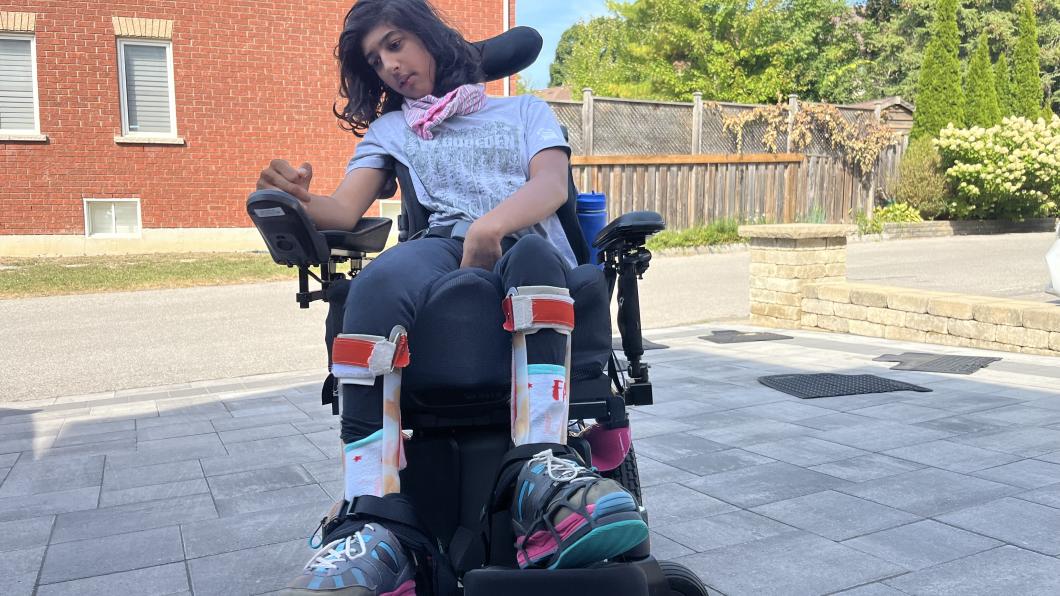
How one mom came to embrace technology for her child
By Anchel Krishna
When your child has a disability, medical gear may become part of your world before you're emotionally ready for it.
It starts with suggestions from therapists or doctors—often when most parents are marvelling at their child’s first steps or words.
In our case, a physiotherapist dropped off a catalogue filled with mobility equipment and asked us to consider a standing frame to help our daughter Syona weight bear. The catalogue sat untouched for months.
While we had faced everything else head on, the thought of a stander in our home immobilized me. It symbolized a future that might look very different from what we'd expected or hoped for. It seemed to represent all we’d lost.
However, at some point, my thinking shifted.
I began to see how the stander could enable Syona to do things. And it did. It became the place we could play, paint, colour and bake muffins. Now, as a teen, she still uses it while eating and helping to do things in our kitchen.
By the time Syona was about four, we were the ones asking about a wheelchair. "She's young," the occupational therapist said. "I think she deserves a chance to move around on her own," I said.
Research shows that getting kids with disabilities moving earlier aids their development. After some conversations and a wheelchair trial, her therapist agreed.
Our biggest challenge was getting a chair to fit Syona’s tiny body. But seeing her propel herself around filled my heart with joy in the same way that first steps did years later with her sister.
Now we see mobility products as tools for independence, access and basic functioning. But we still face system and cost barriers to acquiring them.
For example, Syona was a full-time manual wheelchair user. Several years ago, we asked her team about a power chair, because propelling herself is exhausting. She is motivated and does a lot of it herself, but especially for longer distances, we must take over.
For years, we were told to wait on a power chair. The most frustrating reason was that Syona had to "prove" that she could drive one. This was for safety reasons, which I understand.
But compare the process for approving a power chair to how kids learn to walk. No one asks able-bodied children to demonstrate that they can walk before they are allowed to try. They fall, they stumble, and they learn. Somehow, when it comes to kids who need mobility devices, the bar is raised way higher. They must demonstrate they deserve the chance, instead of being given the chance, and learning along the way.
Recently, at age 14, Syona received her power chair and is learning to navigate it. But when she was able to raise herself up to my level by using a new feature, I looked Syona in the eye from an angle I had never seen. And she had the chance to see the world she lives in from a perspective that was new to her. “I can see what’s around me so much better,” Syona said. It was a miraculous moment and one that I will never forget.
Another barrier to technology is cost. Syona's power chair cost $30,922. Ontario's Assistive Devices Program covered $17,861. The Ontario Federation for Cerebral Palsy covered $1,000 and Easter Seals paid for $3,000. Insurance covered $500 and we paid $7,550.25 out of pocket.
Provincial funding systems are outdated and slow. Supplementary funding programs are complicated, timelines rarely align, and families are left managing the gaps. Even when much of what we need is technically covered, the percentage that isn’t still adds up to thousands of dollars. The very systems that are supposed to provide relief often add to our burden.
Then there are pieces of equipment that aren’t covered at all. Something as essential as toileting and bathing aids, which provide supported seating, aren't covered by provincial programs.
Imagine someone took away your ability to safely use the toilet and shower?
Families are forced to make heartbreaking choices, weighing the cost of equipment against other household needs and their children’s independence.
Equipment is not just a tool. It is freedom, dignity and inclusion. When my daughter is in her chair, she can move through the world. When she has the right supports, she can play, learn and be part of her community.
I often think back to that version of me who let the equipment catalogue gather dust. I don’t judge her; she needed a moment to process things. Today I know equipment is about possibility, and I won’t ever get in the way of possibility for Syona again.
Now we need to overhaul funding systems and policies to ensure that they work for, instead of against, children and families.

Like this content? Sign up for our monthly BLOOM e-letter, follow BLOOM editor @LouiseKinross on X, or @louisekinross.bsky.social on Bluesky, or watch our A Family Like Mine video series.